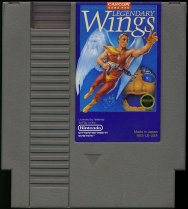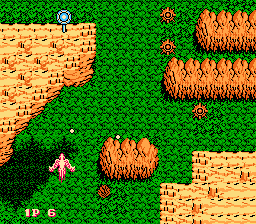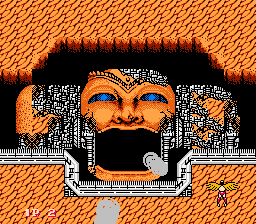
Capcom, already well known in the US for their arcade hits Commando and Ghosts 'n Goblins, was one of the original third parties in Japan and the US. Like Nintendo and the other companies, they already had four years of ready-made product to translate and sell in the US... and like Nintendo and the other companies, their rush to get it out fast sometimes had a detrimental effect on the game. The two classic examples, Bionic Commando and Konami's Metal Gear, are great games that are so marred by the sometimes silly, mostly incomprehensible English dialogue that they became impossible to take to the end. Strider, too.
Even their later Disney titles suffered from these really bad dox, and if it weren't for the bleeding-edge visuals, cool sound and addictiveness of their games they'd be just another Mindscape. And - getting back on subject - Legendary Wings was one of many of Capcom's Japanese efforts that saved the American office's shoddy packaging time and again in the old days. Take! These broken wings!
If Capcom wrote the manual that way it'd at least be entertaining, but instead they use words like they were being rationed, using 2 sentences to tell us how "Ares" (their quotes) gives two men wings of courage and love to save the world from some unexplained threat. This game is an arcade port, which some people might have trouble believing if it wasn't for emulators (I personally just barely remember the arcade game). It must have not been a major commercial hit anywhere, especially considering Capcom didn't even bother releasing this game on Famicom. As a result, this game has become among the handful of NES carts wanted by Japanese collectors. Pac-Mania is another big one. Almost in response to this, quite a few of the currently-produced FC multicarts in Japan recently have featured one or both of these games inside. And so our heroes fly, and fly, and fly and fly and fly. Which is great and all, but these courageous young men would be nowhere without the gun they have, which they apparantly provided themselves. "Ares" isn't so helpful after all, huh? Like most shooters, you can power up your weapon with lazy-flying P items, from single to double to a ring laser to an odd pulse jobbie... to the Firebird. The boundary between man and bird gets blurred as you become ze mythical bird, who can take three hits before being demoted to human.
The smoke can work for you, though - one gun turret or ground target per level is hiding a hole which shoots out its own smoke. Hit it and you enter a bonus horizontal stage where, unmolested by enemies, you can grab Egyptian gold crap and hearts which lead to continues. After defeating the same dragon at the end of every overhead bit, you enter what looks like the Parthenon and go through one more side-scroller bit. There you face more or less the same odd bio-machine boss for each of the five levels, with a little extra treat at the very end. Ooooooon.. I like this shooter, and I think it oughta get a little more respect. I mean, Capcom released a ton of cool-o stuff around this time, so this got a little overshadowed at the time, perhaps. When you think of NES shooters, you probably think of Life Force and Gun Nac anyway. Even so, you should give this a whirl too. The presentation ain't bad either. This being 1987, Capcom actually got a couple of real artists for their NES games. Although there are more colors used in a cup of Trix yogurt than in this game, I like how the themes go from prehistoric to Greek to technomodern through the levels. And the music is purely awesome. Someone needs to NSF it quickly; all the rest of the Capcom library has. The game itself is I think harder than any of Konami's NES shooters, especially near the end as levels are filled with turrets located above walls so you can't shoot them. Like Gradius, though, the game is quite possible at the end even if you lose your powerups. A good joystick is recommended for avoiding shots if you find yourself in this situation, though.
1999.8.19 Back.... | |||||||||||||||||||






